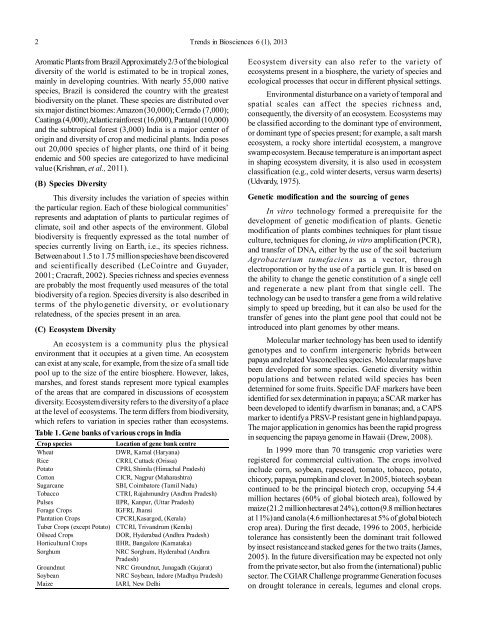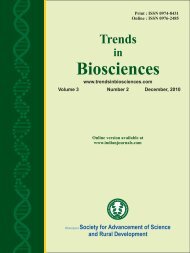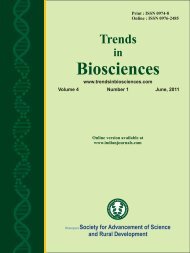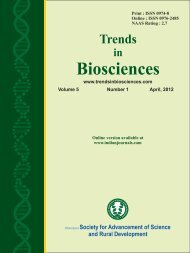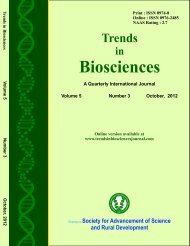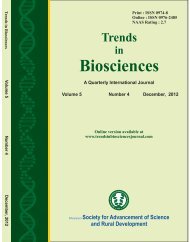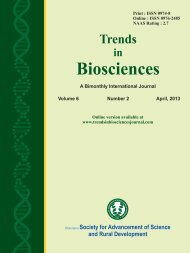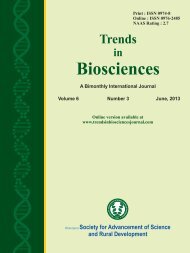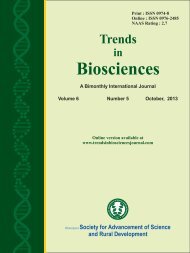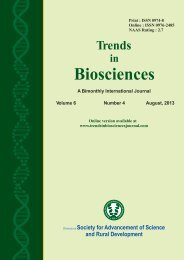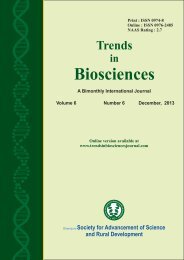TRENDS IN BIOSCIENCES 6-1, 2013 EDITION
CALL FOR RESEARCH PAPERS
CALL FOR RESEARCH PAPERS
Create successful ePaper yourself
Turn your PDF publications into a flip-book with our unique Google optimized e-Paper software.
2 Trends in Biosciences 6 (1), <strong>2013</strong><br />
Aromatic Plants from Brazil Approximately 2/3 of the biological<br />
diversity of the world is estimated to be in tropical zones,<br />
mainly in developing countries. With nearly 55,000 native<br />
species, Brazil is considered the country with the greatest<br />
biodiversity on the planet. These species are distributed over<br />
six major distinct biomes: Amazon (30,000); Cerrado (7,000);<br />
Caatinga (4,000); Atlantic rainforest (16,000), Pantanal (10,000)<br />
and the subtropical forest (3,000) India is a major center of<br />
origin and diversity of crop and medicinal plants. India poses<br />
out 20,000 species of higher plants, one third of it being<br />
endemic and 500 species are categorized to have medicinal<br />
value (Krishnan, et al., 2011).<br />
(B) Species Diversity<br />
This diversity includes the variation of species within<br />
the particular region. Each of these biological communities’<br />
represents and adaptation of plants to particular regimes of<br />
climate, soil and other aspects of the environment. Global<br />
biodiversity is frequently expressed as the total number of<br />
species currently living on Earth, i.e., its species richness.<br />
Between about 1.5 to 1.75 million species have been discovered<br />
and scientifically described (LeCointre and Guyader,<br />
2001; Cracraft, 2002). Species richness and species evenness<br />
are probably the most frequently used measures of the total<br />
biodiversity of a region. Species diversity is also described in<br />
terms of the phylogenetic diversity, or evolutionary<br />
relatedness, of the species present in an area.<br />
(C) Ecosystem Diversity<br />
An ecosystem is a community plus the physical<br />
environment that it occupies at a given time. An ecosystem<br />
can exist at any scale, for example, from the size of a small tide<br />
pool up to the size of the entire biosphere. However, lakes,<br />
marshes, and forest stands represent more typical examples<br />
of the areas that are compared in discussions of ecosystem<br />
diversity. Ecosystem diversity refers to the diversity of a place<br />
at the level of ecosystems. The term differs from biodiversity,<br />
which refers to variation in species rather than ecosystems.<br />
Table 1. Gene banks of various crops in India<br />
Crop species<br />
Location of gene bank centre<br />
Wheat<br />
DWR, Karnal (Haryana)<br />
Rice<br />
CRRI, Cuttack (Orissa)<br />
Potato<br />
CPRI, Shimla (Himachal Pradesh)<br />
Cotton<br />
CICR, Nagpur (Maharashtra)<br />
Sugarcane<br />
SBI, Coimbatore (Tamil Nadu)<br />
Tobacco<br />
CTRI, Rajahmundry (Andhra Pradesh)<br />
Pulses<br />
IIPR, Kanpur, (Uttar Pradesh)<br />
Forage Crops<br />
IGFRI, Jhansi<br />
Plantation Crops<br />
CPCRI,Kasargod, (Kerala)<br />
Tuber Crops (except Potato) CTCRI, Trivandrum (Kerala)<br />
Oilseed Crops<br />
DOR, Hyderabad (Andhra Pradesh)<br />
Horticultural Crops IIHR, Bangalore (Karnataka)<br />
Sorghum<br />
NRC Sorghum, Hyderabad (Andhra<br />
Pradesh)<br />
Groundnut<br />
NRC Groundnut, Junagadh (Gujarat)<br />
Soybean<br />
NRC Soybean, Indore (Madhya Pradesh)<br />
Maize<br />
IARI, New Delhi<br />
Ecosystem diversity can also refer to the variety of<br />
ecosystems present in a biosphere, the variety of species and<br />
ecological processes that occur in different physical settings.<br />
Environmental disturbance on a variety of temporal and<br />
spatial scales can affect the species richness and,<br />
consequently, the diversity of an ecosystem. Ecosystems may<br />
be classified according to the dominant type of environment,<br />
or dominant type of species present; for example, a salt marsh<br />
ecosystem, a rocky shore intertidal ecosystem, a mangrove<br />
swamp ecosystem. Because temperature is an important aspect<br />
in shaping ecosystem diversity, it is also used in ecosystem<br />
classification (e.g., cold winter deserts, versus warm deserts)<br />
(Udvardy, 1975).<br />
Genetic modification and the sourcing of genes<br />
In vitro technology formed a prerequisite for the<br />
development of genetic modification of plants. Genetic<br />
modification of plants combines techniques for plant tissue<br />
culture, techniques for cloning, in vitro amplification (PCR),<br />
and transfer of DNA, either by the use of the soil bacterium<br />
Agrobacterium tumefaciens as a vector, through<br />
electroporation or by the use of a particle gun. It is based on<br />
the ability to change the genetic constitution of a single cell<br />
and regenerate a new plant from that single cell. The<br />
technology can be used to transfer a gene from a wild relative<br />
simply to speed up breeding, but it can also be used for the<br />
transfer of genes into the plant gene pool that could not be<br />
introduced into plant genomes by other means.<br />
Molecular marker technology has been used to identify<br />
genotypes and to confirm intergeneric hybrids between<br />
papaya and related Vasconcellea species. Molecular maps have<br />
been developed for some species. Genetic diversity within<br />
populations and between related wild species has been<br />
determined for some fruits. Specific DAF markers have been<br />
identified for sex determination in papaya; a SCAR marker has<br />
been developed to identify dwarfism in bananas; and, a CAPS<br />
marker to identify a PRSV-P resistant gene in highland papaya.<br />
The major application in genomics has been the rapid progress<br />
in sequencing the papaya genome in Hawaii (Drew, 2008).<br />
In 1999 more than 70 transgenic crop varieties were<br />
registered for commercial cultivation. The crops involved<br />
include corn, soybean, rapeseed, tomato, tobacco, potato,<br />
chicory, papaya, pumpkin and clover. In 2005, biotech soybean<br />
continued to be the principal biotech crop, occupying 54.4<br />
million hectares (60% of global biotech area), followed by<br />
maize (21.2 million hectares at 24%), cotton (9.8 million hectares<br />
at 11%) and canola (4.6 million hectares at 5% of global biotech<br />
crop area). During the first decade, 1996 to 2005, herbicide<br />
tolerance has consistently been the dominant trait followed<br />
by insect resistance and stacked genes for the two traits (James,<br />
2005). In the future diversification may be expected not only<br />
from the private sector, but also from the (international) public<br />
sector. The CGIAR Challenge programme Generation focuses<br />
on drought tolerance in cereals, legumes and clonal crops.


